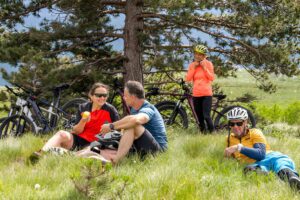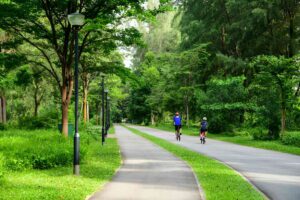The best routes are normally characterized by the ability to provide an optimal mix of physical challenge, safety, scenic beauty, and accessibility. In the realm of trail running, routes will be ranked on these criteria, making them very resourceful for both the novice and experienced runner. Of some of the most famous running routes worldwide, those offering rough terrain, rich biodiversity, and almost otherworldly landscapes easily come to mind. The conspicuous example is the Appalachian Trail, which stretches well over 2,180 miles across many various ecosystems and tough elevation changes that daunt runners greatly in fourteen states.
Unique among the best trail running routes is their ability to envelope a person in nature while providing a very intense workout, such as the trails used in California’s Western States Endurance Run course, which run through historic gold rush country and dramatic altitude changes, offering an intense physical experience and strikingly picturesque backgrounds. Most of these supreme trails feature markers and clean paths so that athletes can have a safe view of the surroundings.
Moreover, many of these routes are created and maintained by local communities and organizations; therefore, this generates a feel of common effort among those who work to make these places capable of being enjoyed by trail running lovers, and simultaneously creates a kind of conservation of these natural places for the future lovers of this sport.
Stepping back a bit, the following sections are going to present some of the places favored by the trail running community and describe some routes that are considered important and special. It’ll zero in on trails of historical significance, symphonies of nature, or technically demanding routes favored by elite athletes. Practical insights will be shared on what gear to pack, how to prepare for varying weather, and local insider tips to help maximize each trail-running adventure. Personal stories from experienced trail runners will also be woven in to provide an honest look at the euphoria and adversity of tackling such iconic trails.

- Highlighted some of the most popular and most scenically beautiful trail running routes in the world.
- Detailed descriptions of each route, explaining ground type, difficulty level, and distance.
- I noted the best times of the year to conduct each run, staying clear of unwanted weather conditions.
- Recommendations for essential gear and equipment one would need on each given trail.
- Safety tips for trail runners, from being prepared for wildlife to wise navigation tips.
- Profiles of some of the world’s most famous trail runners and their favorite routes.
- Cultural and historical details associated with the local environment contextualizing each trail.
- Preparation tips to help get through the tough moments on the trails.
- Accommodation and amenity suggestions near each trail to make your experience easy.
- Links to detailed maps and guidebooks for those who want more.
What are the best trail running routes?
Popular Terms Trail running is running and hiking on trails set in mountainous, forested, or desert environments. The term “single-track” refers to narrow paths, usually wide enough for one person, while the term “switchback” refers to a sharp turn in a trail, usually for ascending or descending purposes. “Elevation gain” refers to the total vertical distance climbed in a route. “Technical terrain” refers to rocks, roots, and other obstacles that may make running difficult.
The best routes for trail running will depend on considerations such as the degree of difficulty of the terrain, the beauties to be seen, and the distance. Many popular routes combine challenging elevations with beautiful landscapes. An ideal route would provide technical features such as rocky faces and switchbacks and then balance them with more runnable features to give trail runners of all skill levels a good challenge. Elevation profile is important as well, since it affects the overall physicality of a run. Trails that loop back to the starting point are often preferred for their convenience.

Runs at Different Times of the Day
The benefit of running at different times of the day remains that it brings a different kind of serenity. The air is brisker and fresher, the streets are quiet, and everything is infused with the soft, golden rays of the rising sun. Physiologically, running in the morning can kickstart your metabolism and set a positive tone for the rest of the day. Thus, it brings about clear mindedness and concentration; hence, very efficient for people with tight schedules in their daily activities. The flip side is that one may experience muscle stiffness, a reduction in body temperature in the lower parts of the body; hence, the right warming-up action should be necessary.
A midday run offers a great way to brighten the doldrums of a workday with an energy boost. The sun is also out enough at this time to provide plenty of Vitamin D, good for both bone health and mood. On the other hand, running in the middle of the day will be more exhausting because temperatures are higher and UV stronger. Runners should keep hydrated and sun-protected. The appropriate window might have to be found creatively by those bound by the clock to work.
Another popular alternative for those who want to unwind from the day’s activities is evening runs. Clearly, the gradual cooling of the day creates more comfortable running conditions, and it allows a very easy and natural way to unwind and process daily events. Conversely, running in the dark produces safety challenges that require reflective gear and cautious route planning. Moreover, for some, performance could be affected by the digestive burden after dinner, so one should see how their body is comfortable.
The Right Gear for Various Kinds of Running
With the right pair of shoes, you may very well make your best friend out of it for road running. Depending on your foot type, proper cushioning and support can make miles of difference in comfort and injury prevention. Moisture-wicking apparel reduces sweat accumulation at the skin surface, which in turn reduces chafing. The other very important thing is the gear appropriate to the weather: lightweight and breathable fabrics in the summertime and insulated, moisture-wicking layers in winter.
Relevant to trail running is a good pair of shoes with strong treads on the outside sole and durable material. A good Trail Running Shoes pair needs to offer sufficient support from ankle twists and protection from rocks and uneven ground. Models of clothes developed specifically against abrasion, allowing for water wicking, will contribute to comfort and security while performing. Gadgets would also be requisite, notable among them a hydration pack, as access to water sources is not reliable along trails.
Track sprinting requires special shoes, often referred to as spikes or flats, designed for speed with lightweight features. Many of these shoes have metal spikes attached to the sole of the shoe for giving the runner increased grip on the track. Lightweight suits or outfits like singlets and short-shorts can be worn to make it easier to move and reduce aerodynamic drag. Stopwatch, lap timers, and heart monitors likely track performance and allow for adjusting training intensity.
Psychological Strategies to Keep You Running Setting both short-term and long-term goals provides a structure that sustains effort over time. Short-term goals might include reaching a certain mileage for the week or bettering times on routinely run routes. Longer-term goals might include running a first marathon or attaining a new personal record. Breaking down aspirations into manageable steps makes them less daunting and more attainable.
Variety can help to alleviate this monotony that may lead to burnout. This may be in the form of changing running locations, alternating between different types of runs to include speed work, long runs, and recovery jogs, along with new challenges or competitions. Joining a running community through running clubs or online forms provides the individual with a sense of support from others and extrinsic motivation.
One can enhance performance and mental toughness through visualization and mindfulness practices. The ability to visualize successful runs, to anticipate quality outcomes of high order, and to practice mindfulness of the body are some of the things that enhance one’s experience of running. Rhythmic breathing, positive self-talk, and focus on form other than speed are some of the techniques that make any run enjoyable and successful.
The Impacts of Diet on Running Performance
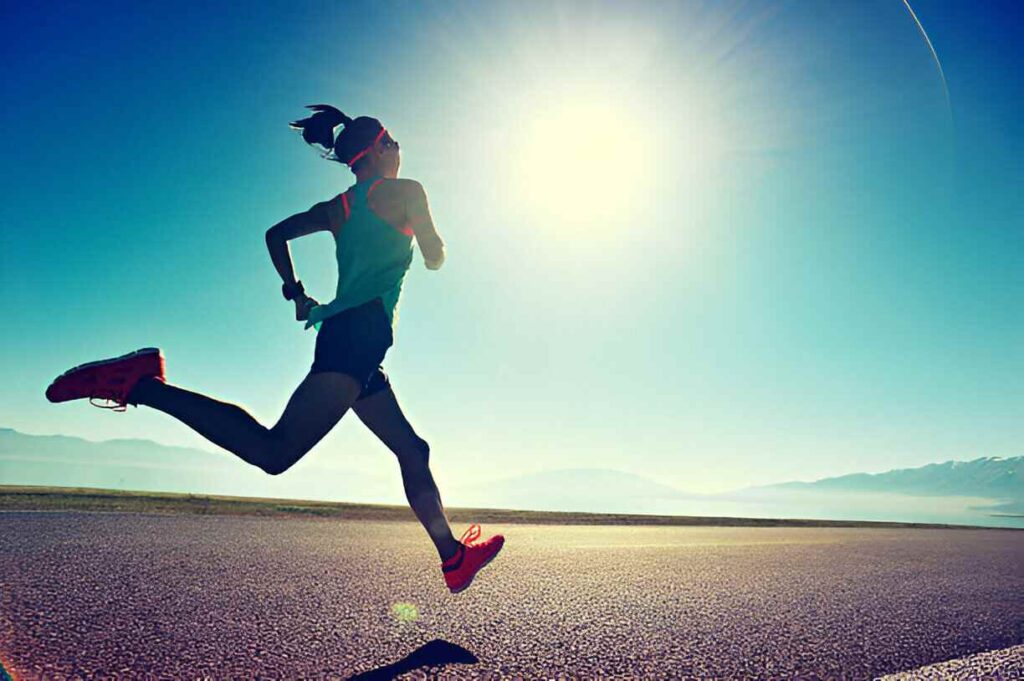
One needs carbohydrates as the chief source of energy when running. On one hand, there are different sources of complex carbohydrates, such as whole grains, vegetables, and legumes, that can provide sustained energy, and on the other hand, there are simple carbohydrates that can give short bursts for immediate needs right before running. Therefore, glycogen stores, being long-term sources of carbohydrates stored in the liver and the muscles, become very important to maintain for extended endurance efforts, so a balanced intake is very important.
These proteins are crucial in the repairing and developing muscles. Sources like lean meats, dairy, beans, nuts are able to provide a supply for amino acids necessary to support recovery from hard training. The proper intake of a protein-based snack or meal immediately after running will speed up the process of repairing the muscles, thus reducing the soreness and preparing the body further.
The other power source, fats, becomes very vital during long-distance running. This means that upon exhaustion of the glycogen stores in the body, healthy fats gotten from sources such as avocados, nuts, seeds, especially fish, would keep running for much longer with the release of energy in a slow and steady way. Nevertheless, striking a sound balance on the intake of fats alongside other macronutrients is very necessary to avoid a feeling of sloth during shorter and more intense workouts.
Hydration cannot be ignored. Proper fluid intake helps in maintaining body temperature, lubricating the joints, and in the transportation of many vital nutrients throughout the body. Water intake before, during, and after runs helps ensure that unhealthy levels of dehydration can never occur, impeding performance. On longer runs, sports drinks packed with electrolytes may come in handy, especially in hot or humid weather conditions, replacing lost minerals.
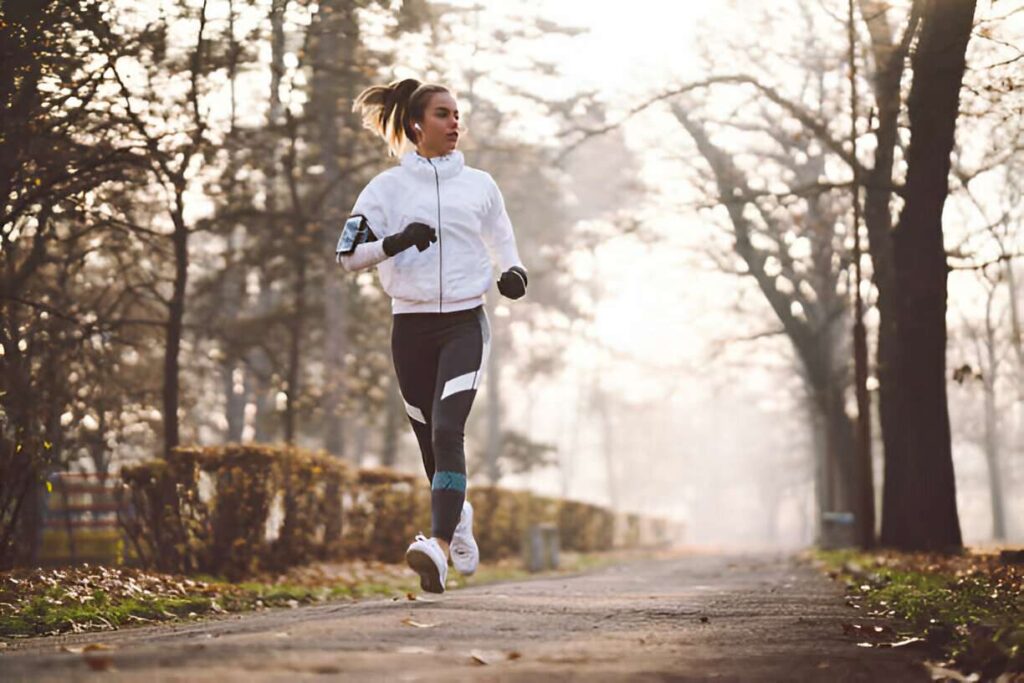
What should I look for when choosing a trail running route?
Look out for the level of difficulty of the trail while choosing a trail running route. This takes into consideration elevation gain, the technicality of the terrain, and trail length to match your present fitness level and experience—having in mind safety and avoiding overexertion.
Research a trail’s location and conditions well in advance. Check the weather forecasts and trail reports to know what to expect, whether about natural hazards or trail closures. Consider facilities, such as parking and toilet facilities, and water on hand to assure safety and comfort.
What are some of the must-haves to bring along on a trail run?
Always carry hydration and nutrition essentials with you while trail running. A hydration pack or bottle will keep you well-hydrated, while energy gels or snack-type foods will help maintain stable energy levels. Replace lost electrolytes, too, particularly in long runs.
You’ll want the right shoes; trail running shoes offer more traction and protection than regular running shoes. You’ll also want to have a first aid kit, a map or GPS device and a source of light if you’ll be out when it’s dark. And don’t forget to protect yourself from the sun with a hat and sunscreen.
How do I know the best places to go trail running in my area?
Begin by looking online for the best trail running routes in your area. Online, many trail running sites and apps offer relevant information, including underlay maps and reviews and ratings from other runners. AllTrails, Trail Run Project, and local running clubs’ websites are good starting points.
You can also get some useful local knowledge from outdoor or running shops in your town. Many staff know the trails around them and often can give personalized advice. Finally, join local trail running groups or social media communities in which you can ask for advice and even run with the group to try new routes.
What are some of the advantages of trail running versus road running?
In comparison to road running, trail running is far more dynamic and engaging. Different land profiles Trigger different muscle sets to engage activity. This variation can allow for a more balanced workout with regards to strengthening and balancing muscle groups. Variability reduces also the repetitive stress put on your joints from similar repetitive movements, possibly reducing the possibility of overuse injuries.
Moreover, the natural environment related to trail running may benefit mental health. The scenic landscapes and fresh air that come with these surroundings help in stress reduction and in improving one’s mood, thus enhancing happiness and relaxation, a clear expression of good mental health; hence, trail running would not only be good for one’s physical but also mental health.
How do I prepare myself for the different terrains in trail running?
Strength train to help with trail running, no matter the surface. Do exercises that target your core, leg muscles, and stability. This will usually give you a better way to negotiate more uneven surfaces, steep climbs, and descents. Add lunges, squats, and balance drills to your routine.
Practice on a variety of terrains to let your body become adapted to the demands. First, run on non-technical trails; then progress through medium routes. Proper trail running shoes with good grip and support can also make a tremendous difference in how well you can move around safely on different terrains.
What do I do if I see wildlife on the trail?
If you are out hiking in the woods and come across wildlife, calm, mindful behavior is the way to defuse a potentially precarious situation. Allow distance between you and the animal, and do not startle it. If it hasn’t seen you, attempt to move away quietly. With large animals such as bears and mountain lions, try to make yourself look big, powerful, and back away slowly.
Before you head out, research the local wildlife that you might encounter and the responses to each. Always carry with you a whistle or bear spray or other deterrents recommended for that area. If you have an aggressive encounter with wildlife, report it to the local authorities so that other trail users may exercise caution.
How do I keep myself safe while running solo on the trails?
Safety while running trails solo can be provided for with a buddy who knows your plan. Share details with them regarding the route you plan to take, when you plan to return, and your contact information. Check in after you are done having fun on this run to let them know everything is okay.
Always run with a fully charged mobile phone and a portable charger. Offline maps and navigation apps, like GPX Viewer, can be downloaded so that in case of deviation from the route or getting lost, these can be followed. Bright and visible colors or reflective jackets ensure better visibility, particularly on the more remote trails. Be constantly alert to one’s surroundings, and do not stick around if one finds himself/herself in an unfavorable situation.
How do I Handle Elevation Shifts While Running Trails?
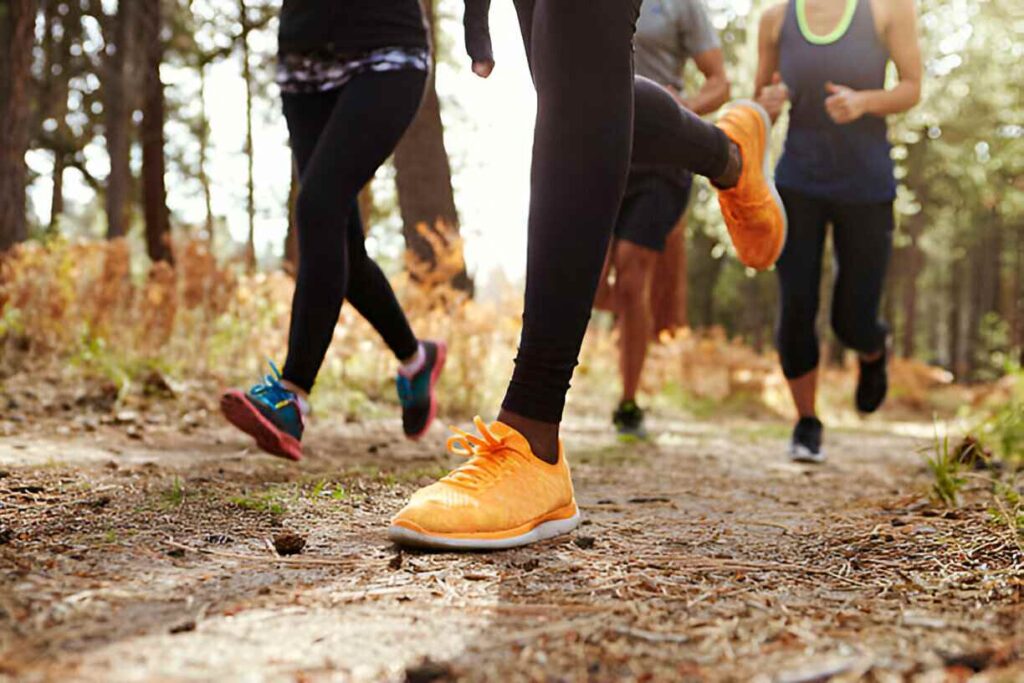
Manage elevation changes with the right conditioning. Add hill workouts and strength training to develop requisite muscle power and endurance. Run routes of variability to get your body used to challenging slopes up and down.
While running, try to keep the intensity equivalent to your breathing rate and avoid hill sprints. Utilize quick, short strides to assist with balance and slightly reach forward at times. On descents, keep back just a little bit while keeping your arms out to the sides for side-to-side balance. Be attuned to your breathing, and don’t be afraid to stop at any time if you feel you might be on the verge of overexertion.
What do I do in case of getting lost during trail running?
However, if you do become disoriented while trail running, it is exceedingly important to stay very calm and not freak out. You just stop moving and replay things in your head—what you’ve done up until this point—and see if you begin to recognize anything familiar around you. Use your map or GPS device to help reorient yourself and get your bearings.
Look for trail markers or signs that can get you back on track. If you have a mobile phone signal, call someone who can guide you or dial emergency services. If you have to wait for help, find as high, visible spot as possible and use any signaling devices you may have, such as a whistle or a mirror, to attract attention.
Are there any particular methods for running downhill?
Specific techniques are involved in running downhill to avoid, at best, potential injuries and to be more efficient. Keep your body slightly forward instead of backward so it aligns with your slope of the hill.
Take shorter, quicker steps, and let gravity help you rather than fight it. Keep your arms out for balance and your core engaged in keeping you stable. The more you can practice running downhill on a variety of terrains, the more confident and experienced you’ll become.
Final Thoughts
The best trail running routes must therefore strike a balance between scenic beauty, variation in terrain, and easy access. Of these destinations, the most outstanding includes the Appalachian Trail, which gives an aggressive experience on its rugged paths and with breathtaking vistas. If one is seeking milder weather, then the West Coast Trail in Canada offers not only stunning ocean views but also rich wildlife. Among the routes in Europe is the Tour du Mont Blanc that gives an alpine adventure unmatched by any other across several countries.
Although city slickers can’t complain aboutvariety in trails of the highest quality, the McKenzie River Trail in Oregon does harbor some of the densest forest scenery available without wandering too far from urban amenities. Those who want to test themselves on a high-altitude trail without sacrificing any of the history and culture can take the Inca Trail in Peru. On another continent, the Larapinta Trail in Australia offers the best routes for those with a leaning toward remote outback landscapes and rich indigenous cultures.
Not every great trail has to be international; the American Southwest presents the Grand Canyon Rim-to-Rim Trail, proper for those seeking both difficulty and reward in an iconic location. Of course, the perfect blend of distance and accessibility is pretty hard to top with the Green Mountain Long Trail in Vermont. Knowledge of the best routes tailored to taste can enhance one’s trail running experience immeasurably, whether one is an elite runner or a casual enthusiast.


